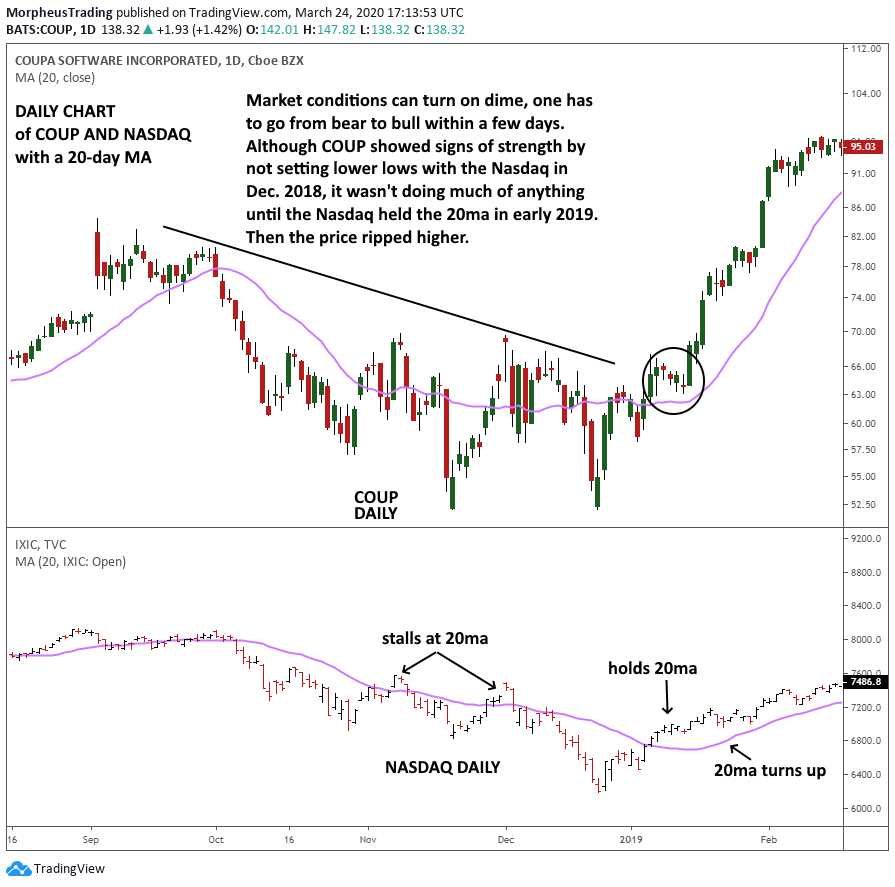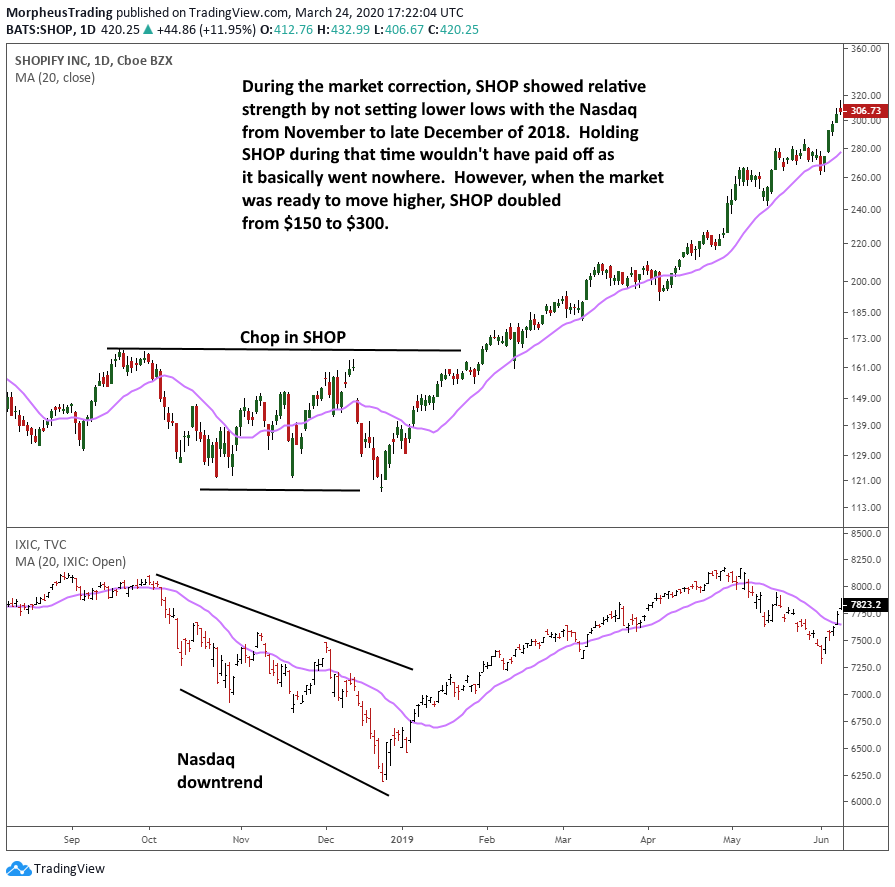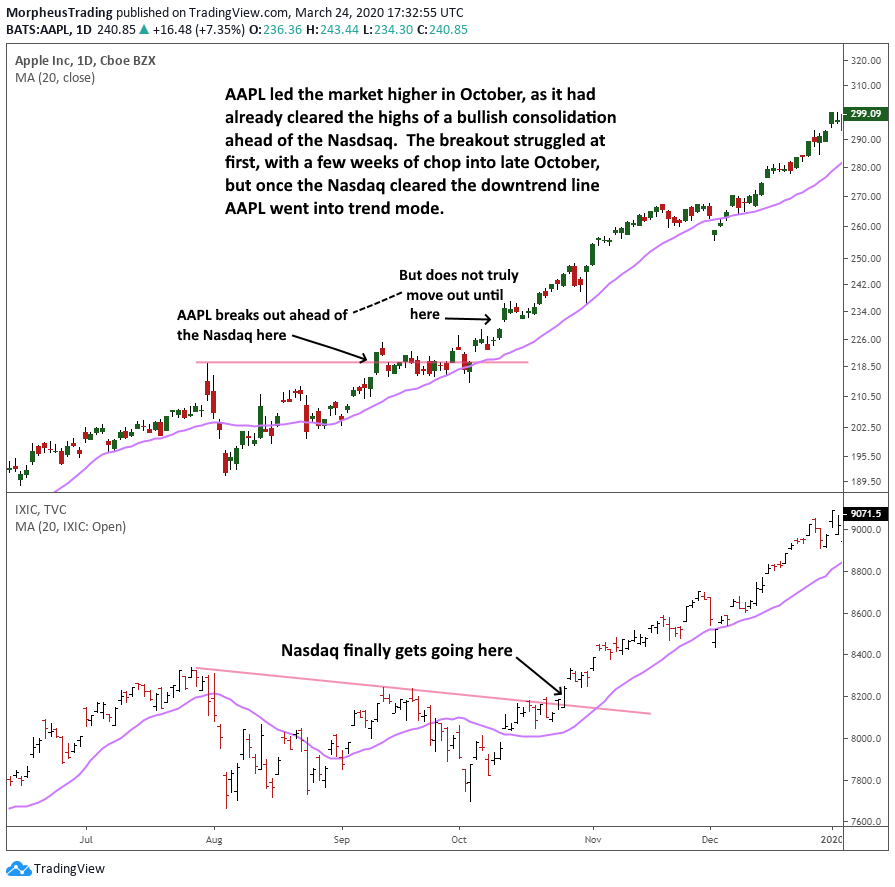
With the stock market clearly in correction mode, it can be difficult for traders who have been suddenly forced to adjust–especially after several months of steadily higher prices.
Here’s our best trading tips and some examples to help you successfully navigate the storm.
The profitable, bullish trade setups that worked a few months ago will not work right now.
As such, it is crucial for trend traders and investors to remain patient and disciplined until market conditions become favorable again.
With the model portfolio of our Wagner Daily report still in 100% cash since the market started falling apart, our subscribers have been benefiting from patiently sitting on the sidelines this month–protecting previously earned profits from the bull market.
Now, we are stalking a new, potential short sale setup in a formerly leading stock that is rallying into resistance and stalling…but still avoiding new buy entries.
That’s the beauty of a trend trading system–you can profit from both up and down markets (while sitting out indecisive markets).
3 Top Tips for Trend Traders Now
Below are three hot trading tips to help keep you on the right track in this volatile stock market. The three charts that follow drive these points home:
- Don’t be a Hero – With the allure of a big win and looking like a genius, it can be extremely tempting to pick a bottom when stocks are getting whacked–but don’t do it!
Doing so usually requires several attempts, at which point traders usually lick their wounds and give up…only to watch the market rip higher the next day!
Has that ever happened to you?
If so, you are probably trying to be a “bottom picking hero” and should immediately change your mindset.
- Avoid the Fear of Missing Out – Do not give in to the natural human “fear of missing out” by chasing price action.
When stocks try to reverse off their lows in a market correction, the bounces that can be sharp and sudden–often aided by institutional short covering.
It can be difficult to watch your favorite stock zoom higher without you in it, but it’s better than buying near the top of a bounce, only to watch the price dive back down.
Remember, what works in a bullish market usually does not in a bearish market!
- Pre-define Your Risk – Every trader and investor should always have some sort of rule-based system to manage risk before putting money to work in the market.
If you don’t already have them, now is the perfect time to create trading rules that dictate when and what you will buy, and how much.
Be realistic about risk by setting in stone the maximum dollar amount you are willing to risk on each trade–which probably should be less than you would be risking in a bull market (unless you’re selling short).
3 Charts That Show Why Patience Pays!
Trying to make too many trades during a market correction can easily lead to spinning your wheels. Check out the three powerful charts below to understand why:
1. Coupa Software [$COUP]
Wait for Broad Market Confirmation to Avoid the Chop
The chart below compares the price action of NASDAQ Composite Index (bottom panel) to $COUP (top panel) from early last year:

After the NASDAQ Composite stalled at the 20-day moving average in November and December, it fell to a new low a few weeks later.
During that market sell-off, $COUP showed early relative strength by not following the NASDAQ to new lows.
However, the subsequent breakout and sharp rally in $COUP did not occur until after the NASDAQ finally rallied and held above its 20-day moving average.
2. Shopify [$SHOP]
What Doesn’t Go Down Becomes the First to Go Up
It can be simple and straight-forward to spot a stock showing relative strength during a broad market correction.
It will typically trade in a sideways pattern, even as the major indices are setting new lows.
Then, it becomes the first stock to rocket higher when the broad market eventually reverses.
After showing relative strength to the NASDAQ in late 2018, $SHOP blasted off to double its share price just five months later.
On the chart below, notice how the NASDAQ’s reversal back above the 20-day moving average is the spark that lit the $SHOP fire:

Whenever a stock has so much relative strength that it holds steady while the major indices are making lower lows, what do you think happens to the stock price when the market eventually reverses higher as well?
That stock typically becomes among the first to rocket higher!
3. Apple [$AAPL]
When Relative Strength Leads a Market Higher
In the first two charts, we saw stocks with relative strength that waited for the NASDAQ to move higher before breaking out.
Even better is when a stock is so strong that it actually breaks out and moves higher ahead of the market.
This was the case with $AAPL starting around September of 2019:

It’s easy to point to this example like $AAPL as a case in favor of trying to pick a bottom.
Still, even though $AAPL technically broke out before the NASDAQ, there were still a few weeks of sloppy, choppy price action before the rally kicked into high gear.
It took the confirmation of strength in the broad market to propel the price of $AAPL higher.
Again, there was plenty of time to buy the Apple breakout and capture most of its gains without trying to pick a bottom.
What tools can help you identify a bottom?
As demonstrated on the charts above, one simple technique is applying a 20-day moving average to the NASDAQ Composite, then waiting for the price action to break above it and hold for a few days.
Once the Nasdaq or S&P 500 is above the 20-day EMA, one should look for stocks that have not made lower lows with the market and are trading within 15-20% of a recent high.
How to Avoid Being a “Bottom Picking Hero”
The trading tips and charts in this article should reinforce the mindset that there is never a need to try to catch a market bottom.
Rather, wait for the market to prove it’s finding a bottom by letting the setups come to you (rather than forcing them).
In the current environment, The Wagner Daily model portfolio is now selectively looking to profit from new short sale setups, as weak stocks rally into resistance.
Still, we will remain mostly on the sidelines in cash, waiting for favorable conditions to put money to work.
Sign up now to receive our best swing trading setups every night–complete with exact entry, stop, and target prices to manage risk.
